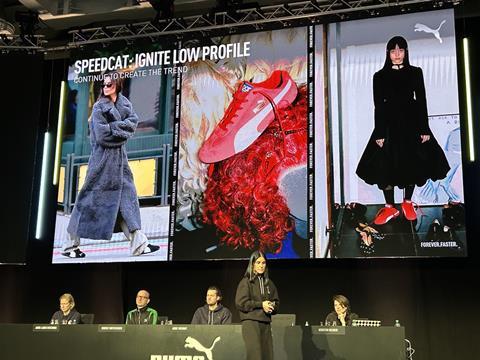Puma is facing a crucial year in a difficult market environment. In his second year as CEO, Arne Freundt wants to sharpen the brand profile and raise consumer awareness in core markets. The foundation for future growth was laid in 2023, says Freundt, and now comes the attack of the self-proclaimed challenger. He and his management explained how this is to be achieved at the main press conference, which we have summarized.

In CEO Arne Freundt’s view, 2023 has “laid the foundation for future growth that is based on increased brand desirability and improved sales quality.” Puma has established a “new marketing organization,” appointed new management teams in the US and China, and reduced inventories to a “healthy level” since the previous year. But the current year promises to be challenging, Freundt said, and he expects growth to occur only in the second half. However, the Puma brand is already planning its first highlight in April, when, in Paris, it will be launching its first brand campaign in ten years and reinvigorating the decade-old slogan “Forever. Faster.” This brings us to the first building block for Puma’s presented success strategy: a higher brand consideration.
Read here about the financial outlook of Puma
Puma’s goal: Brand consideration for performance and sports
In the eyes of Freundt, Puma performs well when it comes to what marketers call brand awareness, but there “is still a lot of potential in the mid and lower marketing funnel,” said Freundt. Freundt wants consumers in China and the US to recognize Puma even more as a performance sports brand.
Brand-tracking tools have informed Chief Product Officer Maria Valdes that certain brand values have not yet reached potential buyers. The brand campaign, for which Freundt himself is co-responsible, intends to change that — but without increasing the marketing budget, which accounts for about 10 percent of total sales. Instead, Freundt said, Puma seeks to “use the budget in a more targeted and different way.” In his view, Puma has, in recent years, neglected to measure the effects of its marketing campaigns and had too many “product campaigns. But it needs a mix of brand and product marketing.”

Retail: Puma wants to increase business with JD Sports, Snipes, Foot Locker
The US and China are already prominent in Puma’s marketing, but the company seeks to change its business somewhat in these two markets, said Freundt: “We have to take out the non-desirable business; we need more desirable business.” The CEO’s goal is to reduce the off-price business to 10 to 15 percent. The same goes for the rest of the global market, but the need is pressing here, especially in the US.
In China, the company wants not only to strengthen its digital business (Tencent is a crucial partner here) but also to increase the sales areas of mono-brand stores at malls in good locations.
According to Freundt, however, it should be possible to push higher-priced business in Europe as well. “We have significantly not enough market-share at retailers like Snipes, JD Sports and Foot Locker. We need to incubate that,” said Freundt.
Brand, China, the US and the retail business are all huge “opportunities” for the CEO. In his view, Puma has done its homework in the product area: “On the product side, we feel very comfortable. Now we must build the consideration.” The management team is convinced that its shoes in running (especially with nitro technology), football and basketball are excellent. The brand campaigns are now to be based on these products to “strengthen the credibility in performance to win authenticity in sports culture.”
Puma: Sport style follows sport performance
For Puma, there must be parallel success in sport style. This includes many collaborations with the likes of A$ap Rocky, Rihanna, Ive or Dua Lipa. As Valdes clarified, Puma has so far “tried to maximize trends. This time is over. We want to pioneer in trends.” To this end, the company intends to focus on the future, and in particular on “A-level collaborations.” The goal must be “to establish new trends.”
Hence the tests Puma is conducting now in South Korea, for example. For the coming months, Puma is focusing on the “low-profile trend,” especially with new Speedcat models with “elevated distribution at higher price points in 2024 and a broader distribution at JD, Footlocker and so on in 2025,” added Freundt.
Freundt sees opportunities for his brand, especially among very young consumers, who will not buy at the highest price points.
Puma and sustainability
For young consumers, sustainability is part of a good brand architecture. How far Puma has come here was shown by Chief Sourcing OfferAnne-Laure Descours, who, in a few days, will also be presenting the company’s 200-page Sustainability Report. At the press conference, Descours emphasized that the company has new and more ambitious science-based targets both for its own operations (Scope 1+2 emissions) and for the supply chain (Scope 3 emissions). Puma has already reduced absolute Scope 1+2 emissions by 85 percent since 2017. By 2030 it expects to raise this figure to 90 percent. The company will be scaling up fiber-to-fiber recycling in the Re:Fibre project and expects to implement it for all replica jerseys in 2024.
Puma’s sustainability efforts are also receiving “strong external recognition” in the form of awards and rankings, said Descours.
Puma shareholders: Freundt wants to build trust
At the time of this writing, Puma’s stock price sits at about €41, down from a five-year peak of €114.70 in November 2021. Although the price rose slightly after the press conference, it is still a long way from where Puma wants it to be. One thing the company wants to do to gain the trust of its shareholders is taking advantage of the “Year of Sports” and make clear marketing efforts with the European Football Championship, the Copa America and the Olympic Games and the year’s other events.
Freundt will, in any case, be striving to “continue to build trust in the new management. This won’t happen overnight,” he said at the end of the press conference.

























